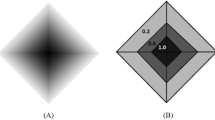Abstract
Besides topological relations and approximate relations, cardinal directions have turned out to be an important class of qualitative spatial relations. In spatial databases and GIS they are frequently used as selection criteria in spatial queries. But the available models of cardinal relations suffer from a number of problems like the unequal treatment of the two spatial objects as arguments of a cardinal direction relation, the use of too coarse approximations of the two spatial operand objects in terms of single representative points or minimum bounding rectangles, the lacking property of converseness of the cardinal directions computed, the partial restriction and limited applicability to simple spatial objects only, and the computation of incorrect results in some cases. This paper proposes a novel two-phase method that solves these problems and consists of a tiling phase and an interpretation phase. In the first phase, a tiling strategy first determines the zones belonging to the nine cardinal directions of each spatial object and then intersects them. The result leads to a bounded grid called objects interaction grid. For each grid cell the information about the spatial objects that intersect it is stored in an objects interaction matrix. In the second phase, an interpretation method is applied to such a matrix and determines the cardinal direction. These results are integrated into spatial queries using directional predicates.
This work was partially supported by the National Science Foundation under grant number NSF-CAREER-IIS-0347574.
Access this chapter
Tax calculation will be finalised at checkout
Purchases are for personal use only
Preview
Unable to display preview. Download preview PDF.
Similar content being viewed by others
References
Schneider, M. (ed.): Spatial Data Types for Database Systems. LNCS, vol. 1288. Springer, Heidelberg (1997)
Frank, A.: Qualitative Spatial Reasoning: Cardinal Directions as an Example. International Journal of Geographical Information Science 10(3), 269–290 (1996)
Goyal, R., Egenhofer, M.: Cardinal Directions between Extended Spatial Objects (2000) (unpublished manuscript)
Skiadopoulos, S., Koubarakis, M.: Composing Cardinal Direction Relations. Artificial Intelligence 152(2), 143–171 (2004)
Haar, R.: Computational Models of Spatial Relations. Technical Report: TR-478, MSC-72-03610 (1976)
Skiadopoulos, S., Sarkas, N., Sellis, T., Koubarakis, M.: A Family of Directional Relation Models for Extended Objects. IEEE Trans. on Knowledge and Data Engineering (TKDE) 19(8), 1116–1130 (2007)
Allen, J.F.: Maintaining Knowledge about Temporal Intervals. Journal of the Association for Computing Machinery 26(11), 832–843 (1983)
Chang, S.K.: Principles of Pictorial Information Systems Design. Prentice-Hall, Englewood Cliffs (1989)
Papadias, D., Egenhofer, M.: Algorithms for Hierarchical Spatial Reasoning. GeoInformatica 1(3), 251–273 (1997)
Papadias, D., Theodoridis, Y., Sellis, T.: The Retrieval of Direction Relations Using R-trees. In: Karagiannis, D. (ed.) DEXA 1994. LNCS, vol. 856, pp. 173–182. Springer, Heidelberg (1994)
Papadias, D., Egenhofer, M., Sharma, J.: Hierarchical Reasoning about Direction Relations. In: 4th ACM workshop on Advances in Geographic Information Systems, pp. 105–112 (1996)
Author information
Authors and Affiliations
Editor information
Editors and Affiliations
Rights and permissions
Copyright information
© 2010 Springer-Verlag Berlin Heidelberg
About this paper
Cite this paper
Chen, T., Schneider, M., Viswanathan, G., Yuan, W. (2010). The Objects Interaction Matrix for Modeling Cardinal Directions in Spatial Databases. In: Kitagawa, H., Ishikawa, Y., Li, Q., Watanabe, C. (eds) Database Systems for Advanced Applications. DASFAA 2010. Lecture Notes in Computer Science, vol 5981. Springer, Berlin, Heidelberg. https://doi.org/10.1007/978-3-642-12026-8_18
Download citation
DOI: https://doi.org/10.1007/978-3-642-12026-8_18
Publisher Name: Springer, Berlin, Heidelberg
Print ISBN: 978-3-642-12025-1
Online ISBN: 978-3-642-12026-8
eBook Packages: Computer ScienceComputer Science (R0)




